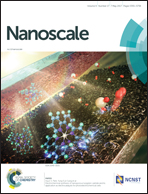A CO monolayer: first-principles design of a new direct band-gap semiconductor with excellent mechanical properties†
Abstract
Group V monolayers, e.g., nitrogene, phosphorene, arsenene, and antimonene have recently emerged as attractive candidates for electronic and optoelectronic applications. However, these pristine monolayers are not able to possess direct band gaps suitable for ultraviolet–blue photoresponse. First-principles calculations show that the Pmma-CO monolayer has a direct band gap of 2.4 eV, and predict that the system has a good stability. Unlike an easy direct–indirect gap transition under small strains in phosphorene, the direct band gap feature of Pmma-CO is maintained under a strain up to 12%. Surprisingly, Pmma-CO shows excellent mechanical stability with an anisotropic in-plane stiffness up to 475.7 N m−1 along the b direction, which is higher than that of graphene. The in-plane hole carrier mobility is predicted to be 746.42 cm2 V−1 s−1, similar to that of black phosphorene. When synthesized, the Pmma-CO monolayer may have great potential in the design of new ultraviolet/blue optoelectronic devices.



 Please wait while we load your content...
Please wait while we load your content...